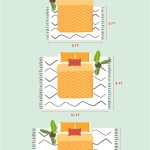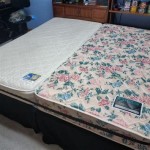Do Plastic Mattress Covers Protect Against Bed Bugs?
Understanding the effectiveness of plastic mattress covers in protecting against bed bugs is crucial for safeguarding your sleep environment and overall well-being. This article delves into the essential aspects of this topic, examining the role of plastic covers in preventing bed bug infestations and maintaining a pest-free sleeping space. Read on to discover the key considerations and how they impact the protective capabilities of plastic mattress covers. ### Physical Barrier Plastic mattress covers serve as a physical barrier, preventing bed bugs from directly accessing the mattress surface. Bed bugs are small insects that can easily crawl through cracks and crevices. A well-fitted plastic cover creates a seal around the mattress, making it difficult for bed bugs to penetrate and establish an infestation. ### Moisture Resistance Bed bugs thrive in warm, humid environments, making it essential to keep bedding dry. Plastic mattress covers are moisture-resistant, which helps prevent the accumulation of moisture that attracts bed bugs. By keeping the mattress dry, plastic covers create an unfavorable environment for bed bug infestations. ### Visibility and Inspection Unlike traditional fabric mattress covers, plastic covers are transparent, allowing for easy inspection of the mattress surface. This enhanced visibility enables early detection of bed bugs or their eggs, allowing for prompt treatment and prevention of further infestation. ### Heat Retention Plastic mattress covers tend to trap body heat, creating a warmer sleep environment. While this can be beneficial in cold weather, it may also attract bed bugs, as they prefer warmer temperatures. It is important to balance the warmth provided by the plastic cover with maintaining a comfortable sleep temperature. ### Allergy Considerations Plastic mattress covers can be beneficial for individuals with allergies or sensitive skin. They create a barrier between the bedding and the mattress surface, reducing exposure to dust mites, allergens, and other irritants. However, it is essential to choose a high-quality, hypoallergenic plastic cover to minimize the risk of allergic reactions. ### Maintenance and Care Proper maintenance and care of plastic mattress covers are crucial for their effectiveness. They should be cleaned regularly using a damp cloth and mild detergent. Avoid using harsh chemicals that could damage the plastic or attract bed bugs. ### Conclusion Plastic mattress covers can provide a valuable layer of protection against bed bugs when used in conjunction with other preventive measures. They create a physical barrier, resist moisture, enhance visibility, and reduce allergen exposure. However, it is important to consider factors such as heat retention and proper maintenance to ensure their effectiveness in safeguarding your sleep environment. By understanding the essential aspects discussed in this article, you can make informed decisions about using plastic mattress covers to protect against bed bugs and maintain a pest-free sleeping space.
Can You Still Get Bed Bugs With A Mattress Cover

Can Bed Bugs Go Through A Plastic Mattress Cover

The Best Mattress Covers For Bed Bug Protection

Can Bed Bugs Live On Plastic Mattress Covers Pest Control Sleuth

Do Mattress Protectors Prevent Bed Bugs Yes No Here S Why Ecoy

Twin Size Bed Mattress Cover Zipper Plastic Waterproof Bugs Protector Mites Com

Full Size Mattress Cover Zipper Waterproof Plastic Bed Bug Dust Mites Allergens Com

Bed Bug Mattress Covers 33cm Depth Experts Pestrol

Can You Still Get Bed Bugs With A Mattress Cover

Twin Waterproof Bed Bug Dust Mite Cotton Mattress Protector Bluestone Target







